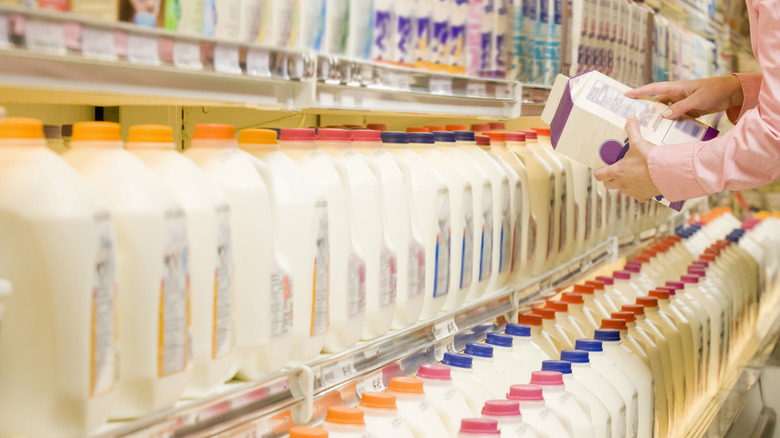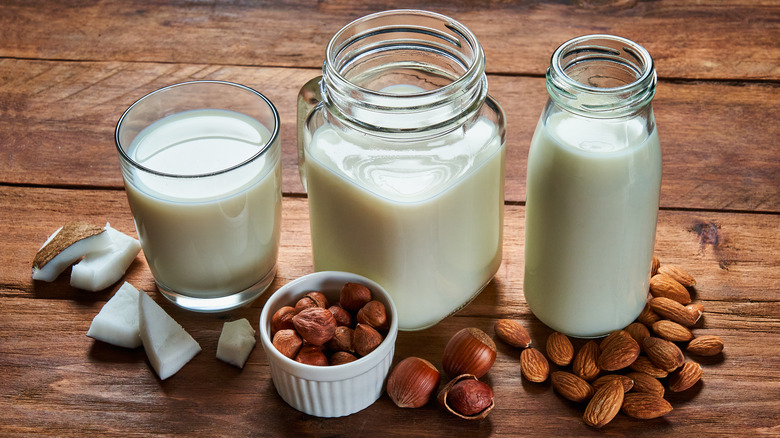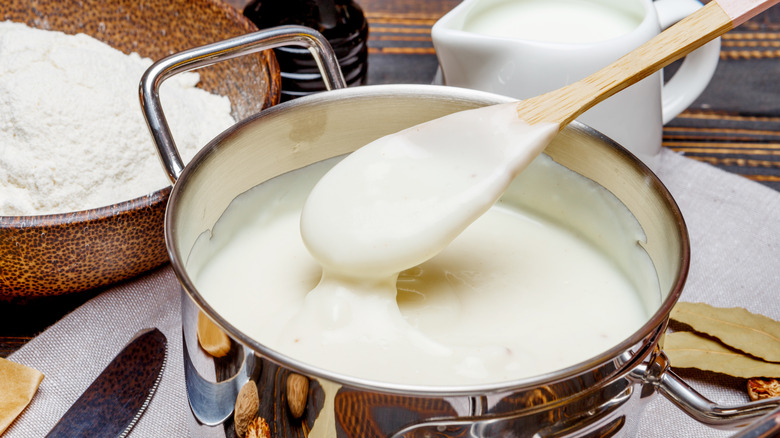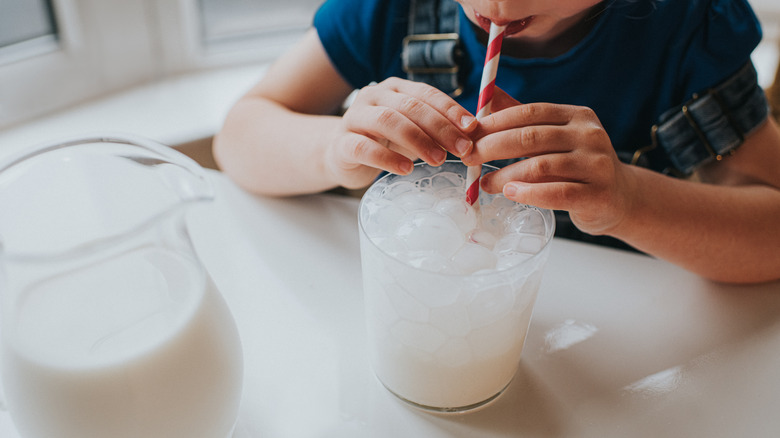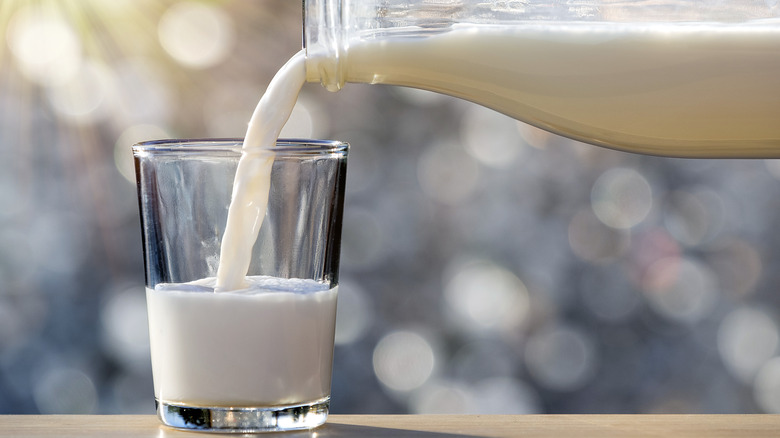The Differences You Need To Know Between Lactose-Free And Dairy-Free Milk
It's a been a long time since buying milk was a simple choice between skim, low-fat, and whole milk. The range of milks on offer now takes up some serious real estate in the supermarket. And while it's a welcome advancement for anyone with allergies or dietary restrictions, the huge array of options can be a little overwhelming to say the least. So what's the difference between lactose-free milk and dairy-free milk, and why would you opt for one or the other?
Simply put, lactose-free milk is regular cow's milk but without lactose. Dairy-free milk refers to any kind of milk that's not made from animals and instead made from plant matter. Some of the most popular dairy-free milks include soy, oat, almond, and rice. When it comes to which one to choose, it all comes down to what you need from a milk. Things you'll need to consider are your food intolerances, whether you follow a vegan diet, what you plan to do with the milk, and even just what taste you prefer.
What is lactose-free milk?
Lactose is a sugar found in all mammal milk, including cow's milk. However, approximately 65% of the world's population (according to MedlinePlus) are unable to properly digest this sugar due to a condition known as lactose intolerance. The good news is that it's easy to create milk without this. It involves adding an enzyme known as lactase, which is naturally found in the body. This breaks the lactose down into separate molecules, essentially pre-digesting it.
Because the process doesn't remove anything, lactose free milk contains all of the same vitamins and nutrients as the cow's milk it started out as. You might find it has a slightly sweeter taste due to the way the sugars have broken down, but it doesn't actually have a higher sugar content. When we refer to lactose-free milk, it's taken to mean cow's milk, as this is what's commercially available. If you want to remove the lactose from sheep or goat milk, or from your favorite brand of cow's milk, you can buy lactase to make your own lactose-free versions at home.
What is dairy-free milk?
Dairy-free milk refers to the many types of milk made from plants. Plants in this case can refer to grains (oat milk), nuts (almond milk), seeds (hemp milk), legumes (soy milk) and even vegetables (potato milk). Technically speaking, a true milk is only one that's obtained from a mammal, but dairy-free milks have adopted the name from their intended purpose as a milk substitute, rather than the way they are extracted.
Most non-dairy milks are made by blending the grains or nuts, etc. with water, then straining out the solids. Some ingredients, such as rice, potato, or cashews, are soaked or cooked first. As this milk is derived from plant matter, it contains neither lactose nor milk proteins, but commercially available options usually include sweeteners, flavorings, or thickeners. It's important to be aware that the non-dairy label does not have the same meaning — it's a term created to ensure that products like coffee creamers are not mistaken for real milk or cream. Non-dairy products often still contain milk extracts, such as the milk protein casein, making them unsuitable for vegans and anyone with a milk allergy.
Lactose-free milk is an easier swap for regular milk
Lactose-free milk is 100% cow's milk, so for the most part, it behaves exactly as regular milk does. It can be substituted anywhere that you would use regular milk with the same results, including in your coffee or baked goods. It does have a slightly sweeter taste, so you may need to adjust the seasoning when making something savory with a lot of milk, like béchamel sauce. Because it behaves like regular milk, it can be made to create other lactose-free dairy products. You'll find commercially available lactose-free butter, yogurt, and, of course, lactose-free cheese that melts just like the real thing.
When it comes to dairy-free milk, each type has its own flavor and properties, so it's more about choosing the right milk for the job. Soy milk is generally a good swap, especially for baking, as it has a high protein content that helps to provide structure, but it can have a strong taste. Likewise, coconut milk is only useful in dishes where you're happy to have a coconut taste, and it can split when heated. Rice milk has a very neutral flavor that's close to cow's milk, but the thin texture means it's not suitable for making sauces.
Barista-style dairy-free milks have been formulated for coffee, meaning they won't separate when added to hot liquid and can be frothed to make cappuccinos. This is done by adding extra fat or thickeners, which can be a help when cooking with barista milks, but just check the label for extra sugar.
Dairy-free milk suits a wider range of dietary restrictions
Lactose-free milk is created specifically for people with lactose intolerance. However, there are some people who can't drink milk due to a milk allergy, which is an immune response rather than an intolerance, with symptoms that range from hives to anaphylaxis. This allergy is triggered by the proteins in dairy, so it can't be avoided by getting rid of the lactose.
Dairy-free milk, on the other hand, contains neither lactose nor the proteins in dairy that can cause an allergic reaction. Dairy-free milk is also suitable for vegans and anyone who avoids milk for religious reasons. But that's not to say that all dairy-free milks are right for everyone. Around 0.7% of Americans suffer from a soy allergy (per Science Direct) and around 0.5-1% are allergic to tree nuts (per AAAAI), which often includes almonds. Some oats contain gluten due to being grown alongside wheat, so celiacs should stick to oat milk labeled as gluten free. But overall, dairy-free milks have the most options for anyone with dietary restrictions or allergies.
Lactose-free milk is higher in protein but also higher in cholesterol
There's no conclusive answer to whether lactose-free milk or dairy-free milk is healthier. The best milk for you will depend on whether you want to get the most amount of protein, reduce your fat intake, or find a good source of vitamins. Lactose-free milk only really varies when it comes to fat content. An 8-ounce glass contains around 8 grams of protein and is a good source of calcium. Saturated fat in an 8-ounce serving ranges from 0.3 g to 4.5 g, with cholesterol ranging from 5 mg to 24 mg.
Th nutritional content of dairy-free milks changes depending not only on what type of milk it is but also on any additives, which will vary by brand. Soy milk with added protein can contain up to 20 g per 8 ounces, and pea milk contains 4-8 grams. Almond milk, on the other hand, contains just 1g per 8 ounces. No dairy-free milk contains cholesterol, as it's only found in animal products, but they can be high in fat and calories. Coconut milk can contain up to 5 g of fat per serve, and anyone on a keto diet will want to avoid rice milk, which has 22 g grams of carbs in every 8 ounces.
Lactose-free milk is a readily available option for anyone who loves the taste of milk but doesn't tolerate it well. Dairy-free milks can be a healthy alternative to lactose-free milk, as long as you keep an eye on the labels. Or better yet, make your own.
